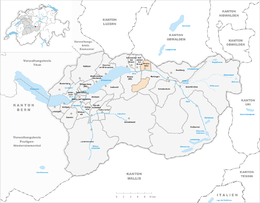Brienzwiler
| Brienzwiler | ||
|---|---|---|

Bernese farmhouse at the Ballenberg Open Air Museum near Brienzwiler village
|
||
|
||
| Coordinates: 46°45′N 8°5′E / 46.750°N 8.083°ECoordinates: 46°45′N 8°5′E / 46.750°N 8.083°E | ||
| Country | Switzerland | |
| Canton | Bern | |
| District | Interlaken-Oberhasli | |
| Area | ||
| • Total | 17.66 km2 (6.82 sq mi) | |
| Elevation | 680 m (2,230 ft) | |
| Population (Dec 2015) | ||
| • Total | 477 | |
| • Density | 27/km2 (70/sq mi) | |
| Postal code | 3856 | |
| SFOS number | 0574 | |
| Surrounded by | Brienz, Grindelwald, Hofstetten bei Brienz, Lungern (OW), Meiringen | |
| Website |
www SFSO statistics |
|
Brienzwiler is a municipality in the Interlaken-Oberhasli administrative district in the canton of Bern in Switzerland. Besides the village of Brienzwiler, the municipality also includes the settlement of Balmhof.
Brienzwiler is first mentioned in 1347 as Wiler am Brünig.
During the Middle Ages Brienzwiler was held by the Ministerialis (unfree knights in the service of a feudal overlord) family of Rudenz. They held the city for the Lords of Ringgenberg. The Rudenz family held the village until 1361 when they sold it to a citizen of Bern. Over the following years it passed from owner to owner and was subdivided until the city of Bern acquired the entire village in 1522. When Bern adopted the Protestant Reformation in 1528, they secularized and annexed the lands of the nearby Interlaken Abbey, including some land near Brienzwiler. Bern assigned Brienzwiler to the newly created, secular bailiwick of Interlaken.
Brienzwiler belongs to the large parish of Brienz. However, since the early 20th century they have their own filial church and cemetery.
Traditionally, the village's economy was based on farming in the Aare river valley and seasonal alpine herding in the alpine valleys. They also received some income from travelers over the Brünig Pass. Beginning in the 19th century, there was a small tourist industry in the municipality and in 1888 a rail station of the Brünig railway line allowed more tourists to visit. Today the local economy is based on wood carving, government jobs, hotel and tourism related work and the Ballenberg Open Air Museum.
...
Wikipedia




